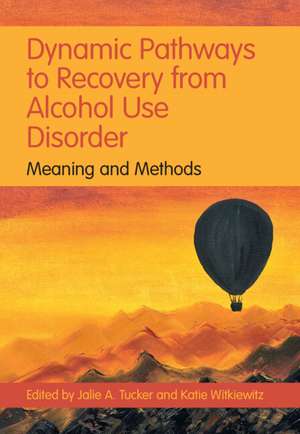Dynamic Pathways to Recovery from Alcohol Use Disorder: Meaning and Methods
Editat de Jalie A. Tucker, Katie Witkiewitzen Limba Engleză Paperback – 5 ian 2022
| Toate formatele și edițiile | Preț | Express |
|---|---|---|
| Paperback (1) | 362.43 lei 6-8 săpt. | |
| Cambridge University Press – 5 ian 2022 | 362.43 lei 6-8 săpt. | |
| Hardback (1) | 966.39 lei 6-8 săpt. | |
| Cambridge University Press – 5 ian 2022 | 966.39 lei 6-8 săpt. |
Preț: 362.43 lei
Preț vechi: 381.51 lei
-5% Nou
Puncte Express: 544
Preț estimativ în valută:
69.37€ • 75.38$ • 58.31£
69.37€ • 75.38$ • 58.31£
Carte tipărită la comandă
Livrare economică 21 aprilie-05 mai
Preluare comenzi: 021 569.72.76
Specificații
ISBN-13: 9781108972260
ISBN-10: 1108972268
Pagini: 528
Dimensiuni: 170 x 244 x 24 mm
Greutate: 0.74 kg
Editura: Cambridge University Press
Colecția Cambridge University Press
Locul publicării:New York, United States
ISBN-10: 1108972268
Pagini: 528
Dimensiuni: 170 x 244 x 24 mm
Greutate: 0.74 kg
Editura: Cambridge University Press
Colecția Cambridge University Press
Locul publicării:New York, United States
Cuprins
Preface; Acknowledgements; Introduction; 1. Historical and contemporary perspectives on pathways to recovery from alcohol use disorder Jalie A. Tucker and Katie Witkiewitz; Part I. Micro Level: The Individual as Change Agent: 2. Biopsychosocial process of change in alcohol use disorder recovery Katie Witkiewitz and Stephen A. Maisto; 3. The role of self-regulation strategies in recovery from alcohol use disorder Corey R. Roos, Sarah Bowen, and Hedy Kober; 4. Neuropsychological and biological influences on drinking behavior change Marsha E. Bates, Julianne L. Price, Jennifer F. Buckman; 5. Lifespan developmental perspectives on natural mechanisms of cessation of risky alcohol use and recovery from alcohol use disorder Matthew R. Lee, Yihong Zhao, Thomas Britton, Jenna Saviano, Kaan Kideys, Yimei Li, Colin Boulter, Emery Frick, and Kenneth J. Sher; 6. Mutual help approaches and mechanisms of change J. Scott Tonigan; 7. Time-Varying effect modeling to examine recovery outcomes across four years Ashley N. Linden-Carmichael, Samuel W. Stull, Christy K. Scott, and Michael L. Dennis; 8. Latent variable mixture modeling approaches to investigating longitudinal recovery processes JeeWon Cheong, Adam D. Wilson, and Juhan Lee; Part II. Meso Level: Understanding and Promoting Individual Behavior Change Within Natural Environments: 9. Natural recovery from alcohol use disorder: Patterns, contexts, and the behavioral economics of change Jalie A. Tucker; 10. Individual behavioral interventions to incentivize sobriety and enrich the natural environment with appealing alternatives to drinking James G. Murphy, Ashley A. Dennhardt, and Kathryn S. Gex; 11. Family and social processes in recovery from alcohol use disorder Amber M. Jarnecke, Delisa G. Brown and Alexander J. Melkonian; 12. Community-Based harm reduction approaches for alcohol use disorder Susan E. Collins, Seema L. Clifasefi, Grover 'Will' Williams, Lovella Black Bear and the LEAP Community Advisory Board; 13. Use of mobile technology to understand and improve recovery from alcohol use disorder Matthew R. Pearson, Noah N. Emery and Frank J. Schwebel; 14. Studying recovery in social context: A primer on methods for measuring and modeling social network data in applied recovery research Kevin A. Hallgren; 15. Measuring substance use contexts and substance-free reinforcement Ali M. Yurasek, Samuel F. Acuff and Meredith S. Berry; Part III. Macro Level: Creating Environments, Resources, Incentives, and Policies to Promote Harm Reduction and Recovery: 16. Recovery communities: Resources and settings David Best, Charlotte Hargreaves, Philip Hodgson, David Patton; 17. Disparities in alcohol treatment access in rural areas: Opportunities for change Claire Snell-Rood, Kara Bensley and Laura Schmidt; 18. Recovery, communities, and the organized recovery movement Robert D. Ashford; 19. Alcohol control policy and regulations to promote recovery from alcohol use disorder William C. Kerr and Meenakshi S. Subbaraman; 20. Causal inference approaches to studying recovery from alcohol use disorder Douglas Steinley; 21. Building on collaborative research to co-design SURE recovery, a mobile application for people with experience of alcohol and other drug problems Alice Bowen, Melanie Getty, Casandra Hogan, Paul Lennon, Elle Long, John Strang, and Joanne Neale; 22. Economic methods used to evaluate recovery programs for alcohol use disorder Brady P. Horn; Conclusions and Future directions; 23. Dynamic pathways to recovery from alcohol use disorder: advancing the scientific agenda and policy priorities Katie Witkiewitz and Jalie A. Tucker; Index.
Recenzii
'The chapters in this book of are a uniformly high standard but, in addition to the excellent contributions of the two editors themselves, I found the following particularly useful:Chapter 2 … Chapter 3 … Chapter 10 … and Chapter 16 … These are just a few selections from an outstanding collection.' Nick Heather, Society for the Study of Addiction
Descriere
This book harnesses research to illustrate dynamic processes of recovery from alcohol use disorder. Abstinence is not the only way.
